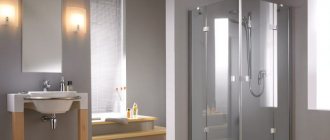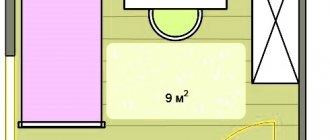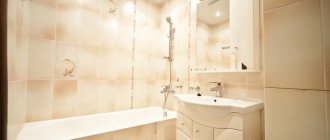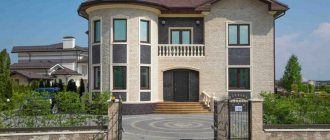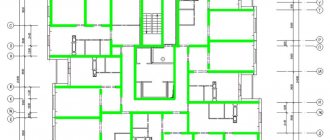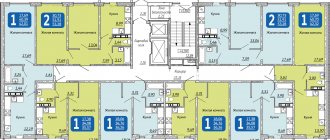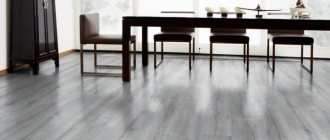Designing a small children's room is all about creating a space that your child will love. Looking for ideas? Small children's rooms can be a challenge when it comes to design and decor. We all want our children to have a bright, uncluttered space to play and do homework. Don't worry: with a little inspiration, it can be easy and inexpensive to transform a child's room into a fun, attractive, and organized space. Thanks to our ideas and tips, you will learn how to decorate a small children's room in an original way. Your baby will be delighted!
Whether you're looking for ideas for girls or ideas for boys, it's important to start with the most essential furniture: a bed and storage organization .
Minimum area and width of a living room
Apartment owners who are planning redevelopment often have questions regarding the area of living rooms. In some cases that have happened in our work, such questions are asked after the redevelopment has been completed, usually unauthorized .
What is the minimum area a living room should have, and under what conditions can it not be so? To prevent such questions from arising in the future, we recommend that you familiarize yourself with the material below.
Minimum area and dimensions of living rooms
According to current SNiPs, the minimum area of a room should be at least 8 square meters (clause 5.3 SP 5.413330.2011) , while its width should not be less than 2.25 meters (clause 6.1.9 SP 31-107-2004) If at least one of these conditions is not met, the room cannot be considered residential.
In our practice, there have been cases when a slight deviation from these standards led to the owner’s refusal to approve the redevelopment . In such a situation, it is necessary either to indicate this room as non-residential (pantry, dressing room, utility room), or to increase the area of the room by moving the partitions.
In both options, it is necessary to make changes to the existing redevelopment project and resubmit the documents to the housing inspection.
Please note that the option of changing the type of premises to non-residential is only possible if the apartment has 2 or more rooms, since a one-room apartment cannot have a living room.
Other conditions under which a room cannot be used as a living room
In addition to the minimum area established by the standards, the presence of a natural light source, that is, a window, is also a determining factor for “assigning” the status of a room to residential.
And in this case, no matter what the size of the room, if it does not have a window, it cannot be residential.
Also, when combining a living room and a kitchen with an electric stove, without visible boundaries between the rooms, the living room becomes a living room (non-residential), but sometimes the housing inspector recognizes the room as residential and gives permission . We discussed this situation in more detail in the article at the link .
This happens due to the lack of clearly regulated norms regarding such associations, especially in one-room apartments; on the BTI plan, the kitchen and room are marked as separate rooms and separated by a dotted line.
Source
Standard area of apartment premises
As has been repeatedly noted in our materials, not every redevelopment can be approved; most often this concerns design projects, the development of which does not take into account the norms and regulations of the current housing legislation.
That is why the development of a redevelopment project should be entrusted only to professionals who, like no one else, are aware of the regulations and have the appropriate SRO approvals, which confirms their competence in this matter.
Along with prohibited activities, which will obviously cause the housing inspector to refuse to issue permission for redevelopment , there are also restrictions regulated by construction and sanitary norms and rules.
The list of these restrictions also includes standards regarding the minimum area of premises in an apartment , non-compliance with which will lead the approval procedure to a dead end already at the initial stage.
The SNiPs directly regulating these restrictions are quite extensive. It is not necessary for the apartment owner to know all the nuances; there are design organizations for this; however, it is possible to summarize the information regarding the minimum allowable area of the apartment and premises, which we have done for your convenience.
Today there are rules that apply to the construction of apartment buildings. According to these standards, the minimum area of an apartment is:
| Number of rooms | Minimum apartment area, sq.m. |
| 1 | 28 |
| 2 | 44 |
| 3 | 56 |
| 4 | 70 |
| 5 | 84 |
| 6 | 103 |
Over the entire period of our organization’s activity, we have had to deal with five- and six-room apartments, but the bulk of our work is still related to 1-3 room apartments. Therefore, we will dwell in more detail on the prescribed standards for these particular apartments.
Minimum area of apartments:
| Number of rooms | Living room, sq.m | Bedroom area, sq.m | Kitchen, sq.m |
| 1 | 14 | 8 | 6 and 5 for kitchen niche |
| 2 or more | 16 and 9 for other residential premises | 8 | 8 and 6 for kitchen niche |
That is, what does the top table mean: - For one-room apartments that are in social rent, the area of the living room cannot be less than 14 square meters. — For two-room (or more) apartments, the area of the common (large) living room cannot be less than 16 square meters, the remaining rooms cannot be less than 8 square meters. meters.
And previously, the housing inspection interpreted this SNiP as the same for all types of apartments, since there was no other way. That is, when SNiP was written there were no other forms of ownership and there was nothing to rely on other than it.
However, recently there has been a tendency towards some changes in the interpretation of these norms: In SNiP, at the bottom of the page there is an asterisk * and the signature “for apartments in social rent” and we see references to this point less and less often. Now it is not uncommon for an apartment to agree on one living room with an area of 8-9 square meters, provided that it meets other standards: the width of the room is at least 2.25 meters or the room must have natural light (i.e. a window), etc. .
Special attention must be paid to the standard height of the apartment’s ceilings. In Moscow, the minimum height between the flooring and the ceiling must be at least 2.5 m, while the permissible height of corridors and other non-residential premises is 2.1 m.
Let's take an example from our practice. Below are the plan for the design project that was provided to us by the customer and sheets of the redevelopment project developed by our organization. In the original version, according to the design project, the partition between the corridor (5) and the living room (2) was shifted in favor of expanding the hallway, while the area of the living room was reduced to an unacceptable 7.4 sq.m., which does not comply with SNiP standards.
Redevelopment according to a design project Our Redevelopment Project
Together with the owner, it was decided to change the redevelopment plan and the corridor was slightly enlarged at the expense of the living room (1) and the living room (2) turned into a living room, as a result of which the project was successfully agreed upon.
You can find out more about this redevelopment project here.
Such inconsistencies in design projects occur very often, as a result the owner spends money on designers whose solutions are inconsistent. You need to understand that a beautiful picture does not mean anything, even if you work with a designer, consultation with experienced designers will not be superfluous, and in some cases it will even help save money.
Our company provides services for design and coordination of redevelopments. If you have a question about the “consistency” of your redevelopment, you can get a free consultation by calling the numbers on the website.
Source
minimum size of a boiler room in a private house
Redevelopment without mistakes: what you need to know when making repairs
For many Muscovites, remodeling an apartment is an opportunity to make their home more comfortable and convenient. This issue is especially relevant for residents of mass-produced houses.
“The current procedure in the capital for approving the redevelopment of premises makes it possible to ensure compliance with construction and sanitary standards when carrying out repair work, and to protect the interests of the owner and his neighbors. Last year, we transferred the government service for approving reconstruction and redevelopment into an electronic form - now residents can submit an application at any convenient time, send documents and track the status of consideration of the application in their personal account on the mos.ru website. The process of obtaining a service has become as transparent and convenient as possible, and the time frame for receiving a decision has been reduced,” said Deputy Mayor of Moscow for Housing, Communal Services and Landscaping Pyotr Biryukov.
By law, major changes to the apartment plan must be approved by the Moscow Housing Inspectorate. Moreover, it is legally correct to obtain permission in advance, before the start of repairs. But in practice, owners often try to approve ready-made alterations. How to properly coordinate renovations in an apartment and what kind of redevelopment cannot be legalized - in the mos.ru material.
What is redevelopment
Redevelopment is called repair or construction - everything that requires changes to the technical documentation (architectural and planning solution). According to the Housing Code of the Russian Federation, this is any work the result of which is reflected in the technical plan of the premises. They can not only affect the apartment itself, but also change the characteristics of the entire house. Therefore, redevelopment and reconstruction require approval.
Strict requirements were introduced due to the fact that redevelopments are often carried out in violation of building codes and regulations. For example, demolition of load-bearing walls in an ordinary high-rise building can lead to partial or complete collapse. Unfortunately, such stories do happen. This violation refers to work that is prohibited. There are two more types of work: those that require approvals and those that can be performed without approval from regulatory authorities.
How to avoid mistakes
Redevelopment rules are regulated by the Housing Code of the Russian Federation, various construction and sanitary standards and regulations, as well as a number of regulations. They protect residents from the wrong actions of their neighbors, says Andrey Kuptsov, head of the engineering survey sector of the State Budgetary Institution Expert Center. The center's specialists examine residential and non-residential premises in apartment buildings to determine the technical condition of load-bearing and enclosing structures after redevelopment, including the development of design documentation.
According to the expert, if the owner of one apartment does everything reliably, using modern materials and technologies, then it is not necessary for another. And this will result, at best, in a conflict with neighbors. Therefore, building standards are the same for everyone.
“The biggest mistake is when people want to improve their living conditions by redevelopment, but forget about the rules. It is impossible, for example, to enlarge the bathroom and kitchen at the expense of living rooms. People think that everything is fine, but it is prohibited. So they worsen the conditions for other residents of the house: incorrect waterproofing - and the neighbors below will experience a flood,” said Andrey Kuptsov. According to him, it is possible to increase the so-called wet zone through the corridor, but this also has its own nuances.
Another common mistake is combining a loggia or balcony with the residential part of the apartment.
“Such redevelopment is prohibited because it disrupts the thermal contour of the building. As a result, there is an additional load on the central heating system, which can lead to significant heat loss and even mold in neighboring apartments. In the capital, in agreement with the Moscow Housing Inspectorate, it is allowed to dismantle the window sill in order to install a wider door block,” says the expert.
The law also prohibits bringing central heating radiators into the loggia. Andrey Kuptsov explains that this is a summer room and the heating system may not withstand temperature changes. “We are forced to refuse technical conclusions and designs, since this work is unacceptable and can lead to a deterioration in the living conditions of other people in an apartment building,” adds the specialist.
According to him, the installation of balconies above the second floor is also prohibited. Such an extension creates additional load on the supporting structures. According to the rules, only residents of the first floors can build balconies for themselves, and only as a non-permanent building. Such balconies on the first floors must be without a heating system, foundation and underground premises. Everything else will have to be dismantled.
In addition, ventilation ducts are not allowed to be hung on the main facades of the house that face the street. This requirement applies to all non-residential premises located on the ground floor of an apartment building. In this case, ventilation should go to the internal facade - in the courtyard of the house. This requirement allows you to preserve the aesthetic appearance of buildings. You can complain about violators to the State Housing Inspectorate of the city of Moscow.
The ventilation duct inside the apartment (between the kitchen and the bathroom) is demolished by enterprising residents, increasing the number of precious square meters. This literally blocks the flow of air into the apartments above and below the riser. The law will oblige you to return everything as it was.
Houses with gas equipment also have their own nuances. For example, you can move the slab to another location with the approval of the Moszhilinspektsiya and provided that the work is carried out by Mosgaz. But you cannot combine a kitchen with a gas stove and a living room. In rooms where there is gas, according to the standards, there must be a separate door to avoid the spread of gas if it leaks.
Before making an opening in a load-bearing wall, it is necessary to carry out calculations and obtain approval. In this case, the structure must be well strengthened. It will not be possible to create heated floors using central heating. Heated floors can only be connected to the apartment’s electrical supply and provided that the allocated electrical power is sufficient.
Muscovites also began to get carried away with adding mezzanines inside the premises, says Andrey Kuptsov. The mezzanine area should not exceed 40 percent of the room area. Sometimes owners forget about this and make the “second floor” much larger. However, such an excess leads to an increase in the load on the load-bearing walls.
“Over time, some things are allowed, some things are prohibited. Today the list of prohibitions consists of 26 points,” says the expert. All of them can be found at the link.
In a simplified manner
Without approvals, you can make simple repairs to the apartment that will not lead to significant changes. According to Andrey Kuptsov, without approval, you can make an opening in a non-load-bearing wall, if this does not change the load on the floors, and replace plumbing equipment without changing its location. It is also allowed to re-lay the floors if the parameters of the room, such as its height, do not change. A sketch of the work performed must be sent to the Moscow Housing Inspectorate for approval. There is no need to coordinate the replacement of finishing coatings on walls, ceilings, or floors - for example, replacing linoleum with laminate or tiles.
hallway options in an apartment with a closet
In a simplified procedure, you can agree on the installation of built-in cabinets, the laying or installation of doorways in non-load-bearing partitions, the rearrangement of a sink in the kitchen, or the replacement of a bathtub with a shower within the boundaries of the bathroom.
Setting up a small bedroom
Small bedrooms, despite their small area, can also be made stylish and cozy. You should give preference to light colors; they can significantly enlarge your bedroom. Add accents of dark and bright colors to your palette.
Light colors are also used for the floor; the material can be either parquet or laminate. When choosing furniture, look for built-in models that won't take up much space.
Calculate the dimensions of the future closet and the dimensions of the chest of drawers for the bedroom so that everything fits harmoniously.
Special cases of redevelopment
When redeveloping a residential building that is a cultural heritage site, two options for carrying out the work are possible. If this affects the subject of protection, then the design documentation for the adaptation of residential premises must be approved by the Department of Cultural Heritage of the city of Moscow. Otherwise, the applicant submits project documentation to the Moscow Housing Inspectorate, which forwards the documents to the capital’s Department of Cultural Heritage. Its specialists prepare a final decision and forward it to the Moscow Housing Inspectorate.
If a house is recognized as unsafe, then it is prohibited to carry out redevelopment and reconstruction.
And the expert calls the open plan, popular in new houses, quite conventional. In any case, the premises there are planned in advance. “Zoning still remains: where there should be a kitchen or bathroom, you cannot make a living room,” explains Andrey Kuptsov.
If you buy an apartment in a new building, where there is nothing but load-bearing walls, you need to start repairs by developing a project and getting it approved by the Moscow Housing Inspectorate. After this, you can begin repairs.
Redevelopment by law
By law, redevelopment must be approved before the renovation begins. To do this, you will need to develop a redevelopment and reconstruction project: it should only be carried out by a design organization with the status of a full member of a self-regulatory organization (SRO). You can check this on the website of the National Association of Surveyors and Designers (NOPRIZ). The State Budgetary Institution “Expert Center” is one of such organizations, and its employees have extensive experience in working with different situations.
Redevelopment can also be done according to a ready-made scheme from the catalog of standard projects already approved by the Moscow Housing Inspectorate. In this case, experts will need to verify on site whether it is possible to carry out the work. “They will check load-bearing and enclosing structures, floors, walls, engineering systems - how reliable their condition is today and how the work that the owner wants to carry out will affect them,” noted Andrey Kuptsov.
From August 2021, it is possible to legalize the redevelopment of an apartment only in electronic form. To do this, you need to collect all the documents and submit an application on the mos.ru website. After all the examinations, usually within 20 days, the owner receives a decision on approval.
Having received the technical conclusion, you can contact the Moscow Housing Inspectorate with an application for the provision of public services. In this case, the applicant must pay an administrative fine for the illegal work carried out.
Disadvantages of large cottages
Oddly enough, the fashion for large houses has not yet passed and one can often see sad pictures of concrete expressionism outside the city.
History is silent about why the little boy is called “Uncle Fedor,” and why he was forced to form a gang without documents and hide from his relatives for a long time. Thanks to a vigilant employee of the rural post office, the fugitive was discovered and defeated by the facts.
Let's consider the most popular reasons not to build a large cottage:
Unfinished. As a rule, large cottages take a long time to build, if not frankly, years. You may end up in construction bondage that will last forever. For this money, you can build a small, comfortable house and live now.
Difficulty selling. The real estate market is overflowing with offers of large and expensive cottages, which are very difficult to sell. And if you talk to an experienced realtor, he will tell you that the cost of such buildings often reaches cost, and in fact, the owners, at best, recoup the costs of building materials.
Inconvenience of movement. Moving around a huge house can quickly become tiring, especially for older people.
Fines and sanctions
The fine for Muscovites for illegal redevelopment of an apartment is set at two to two and a half thousand rubles. For officials in Moscow, fines range from four to five thousand rubles, for legal entities - 40-50 thousand rubles. In this case, the owner will be required to restore the original appearance of the premises. And if this is not done within a certain period, the materials will be sent to court.
Often illegal redevelopments are discovered by neighbors who begin to flood. “If the owner does not respond, they contact the Moscow Housing Inspectorate, its experts will inspect both premises, draw up a protocol, a fine and an order to eliminate the violation. The owner then has two options: return everything to its original position or eliminate the violations and legalize the redevelopment,” says Andrey Kuptsov. At the same time, it will not be possible to ignore the requirements - the owner may even face selling the apartment at auction.
Last year, the Moscow Housing Inspectorate received almost 22 thousand applications for approval of reconstruction and redevelopment. Of these, about seven thousand applications were related to previously completed work. It is difficult for experts to judge how many people do not apply for approvals.
“I don’t think this will cease to be relevant, because people will always have a desire to improve their homes. Everyone wants to improve what they buy. Today apartments are built to be more comfortable than 20–30 years ago. But there are still a lot of people willing,” the expert notes. Therefore, when deciding on a global remodel, you should entrust calculations and approvals to experts.
Source
How to choose an apartment according to the drawing and not overpay
If every square meter counts
A large area does not always guarantee that the apartment will ultimately be comfortable. Its layout is much more important.
You can inspect an apartment on the secondary market - evaluate the view from the window and check how much light there is in the rooms. In a new building, especially at the foundation pit stage, buyers are offered only layouts of specific apartments or a floor plan of a residential complex. For a person who is buying real estate for the first time and has not heard anything about planning solutions, the different options will differ only in area and number of rooms.
I am an interior journalist and write articles analyzing the design and layout of apartments. Property owners shared stories with me about how they chose housing, what they paid attention to, and what design features ultimately turned out to be the most convenient or inconvenient. In this article I will tell you how architects evaluate the layout and why you may end up with fewer meters than you expected.
All layouts are made according to standards
There are very few frankly unsuccessful plans in the real estate market. Still, developers are required to comply with SNPs and Sanpins, and they stipulate strict requirements for housing. But the layout may be more or less suitable for a particular buyer with certain needs.
Someone will not understand why I consider the plans that I discuss in the article to be unsuccessful. For some they will be quite suitable. I chose them as an example only for a situation where the buyer has a strictly limited budget. In this case, you have to squeeze the maximum out of the available space and save on every square meter.
Optimal living room size
The first thing you should pay attention to when choosing the layout of your home is the size of the living room. Naturally, a room with many functions and designed to accommodate several people at the same time cannot be small. Architects and designers consider the minimum area of a living room to be 20 m². As a rule, rooms such as kitchens and dining rooms are also associated with the living room. Practice shows that their minimum sizes are 7 m² and 6 m², respectively. But today these rooms are often integrated into the living room space rather than located in separate rooms. This is done with the aim of more rational use of space.
If you combine the kitchen, dining room and living room, the total area of the room is about 40 m². A few meters will give “demolished” walls. Meanwhile, both the kitchen and the dining room are conditionally separated from the recreation area. A small but functional kitchen peninsula serves as an excellent divider between the kitchen and the dining room. There must be a sufficiently powerful hood above the stove to remove kitchen odors outside the room.
Architects' recommendations for living room space should be considered as a starting point. The area of individual zones can be varied depending on the lifestyle and preferences of the family. For example, a kitchen may not be a peninsula, but a full-fledged set of furniture occupying part of the perimeter. The structure separating it from the dining and relaxation area can be a counter with a built-in aquarium or simply a stone tabletop on a veneered pedestal. The dining room can be combined with the kitchen, i.e. do not separate them from each other, but maintain a conventional border with the living area. The choice of one solution or another is often determined by the size of the room.
Living rooms also have an upper bar that limits their spaciousness. To a greater extent, the limitation is due to the observance of proportions between the area of the living room and other rooms. So, a large living room and a cramped kitchen will not fit well with each other. If you plan to receive a large number of guests, then you need to think about allocating a larger area to the kitchen so that it can serve them. If you don’t have too many guests in your house, then you shouldn’t make the living room too big. It will turn out to be uncomfortable and, thus, will be eliminated from the usable area, performing the function of a large and equally useless hall.
How to choose an apartment on a floor plan
Few buyers invite an architect or designer to select an apartment. It seems that an experienced specialist will correct any layout later, during the renovation. But the designer won't figure out how to fix the polygonal rooms and sloping façade of the building. He will put an armchair and a coffee table in the room and call it a relaxation area. In fact, in 99% of cases this area in the apartment will simply be empty.
Or, during the interior design process, the designer will develop furniture based on an individual project, which will be made to order. The cost of an apartment with such an interior will only increase. In general, it is better to initially choose an apartment in which you won’t have to fix anything, but you can immediately live comfortably.
Let's say you choose an apartment in a new building. They offer you a plan of the entire floor for you to choose a layout. Here's what to look out for:
I will tell you in detail about each item on this list.
guest house rooms on the Sea of Azov
Standard dimensions
In a panel house built in the late Soviet period (including the 1980s) and in the 1990s, the bedroom size ranges from 8 to 15 m2. According to modern ideas that have developed in the 21st century in Russia, a space of 16 m2 per person is considered comfortable. Foreign developers also rely on these same indicators. The ceiling height in an apartment is from 2.5 to 3 m, in a country house this parameter reaches 3.5-4 m. Do not overdo it - ceilings with a height of more than 4 m are included in the design of houses with a special layout, in which one of places are given a characteristic feature - the second light or the upper tier of windows.
Requests from future residents
First, you need to decide on the scenarios for using the apartment. The planning requirements largely depend on who will live in it and how. For example, if the family often receives guests, then the living room should be spacious. Conversely, for a bachelor or an introverted family, a sofa in the kitchen is enough, and the living room can be turned into a large bedroom with a comfortable bed. Families with small children often prefer kitchen-living rooms so that they can cook and look after the child at the same time.
If a large family with grandparents lives in one apartment, then it is better to provide several bathrooms. Such bathrooms are also called master bathrooms in bedrooms. In addition, it is good if the apartment is conditionally divided into private and public parts. Thanks to this, it will be possible to receive guests or watch TV, even if older or younger family members are on vacation. There will be no noise from the living room in the bedrooms.
All these planning requirements are, of course, optional. But a bachelor or a couple without children does not always need a second bathroom, a spacious living room or kitchen, so it is not worth overpaying for them.
Creating a work area
The development of a small nursery presupposes the presence of such a zone; it should be located in the area of maximum illumination, i.e. near the window.
Zoning and layout options for a children's room
The working area of a bedroom with a crib requires the presence of the following important pieces of furniture:
- convenient folding table;
- good chair;
- additional sources of spot lighting.
Possibility of redevelopment
The other extreme is to create the ideal apartment for yourself from scratch. For this reason, buyers are looking for an apartment with an open plan - a concrete box without internal walls and partitions. But in fact, the layout there is still not so free. On the developer’s floor plan, the rooms are conventionally divided into zones—kitchen and bathrooms. Any deviation from this plan will be considered a redevelopment. It needs to be agreed upon, and this is an additional expense.
You can choose something in between and optimize the space for yourself. For example, combine the kitchen and living room, carve out space for a bedroom or an additional nursery. In this case, load-bearing walls and columns, as well as their location, are fundamentally important. It depends on them how the space will be divided into rooms. It will not be possible to demolish the supporting structure or ventilation shaft. These objects will become the conditional boundaries of the premises.
In most panel houses, redevelopment will be minimal. For example, it is only allowed to connect a corridor to a room and move the doorway. In brick houses, usually only the external walls are load-bearing, and any redevelopment inside the apartment is permissible. Monolithic houses are also suitable for redevelopment, but they may have load-bearing projections and columns that need to be used in the interior.
Sometimes it is more profitable to buy a smaller apartment and remodel it. For example, in a one-room apartment with an area of 35-40 m² it is quite possible to allocate space for a bedroom, but the area of a two-room apartment for the same purpose would be 10-15 m² larger. It happens that a living room is even built in place of a hall or corridor, connecting it to the kitchen. Such redevelopment will also allow you to buy an apartment with fewer rooms and save a lot of money.
It is also useful to know:
The shape of the rooms greatly affects the perception of the space of the room. A square room seems larger and makes it easier to place furniture.
The combination of garage and living space should be considered with extreme care. It is always convenient to enter utility rooms without going outside, but the smells of the garage should not waft into the house. It is best to equip the exit to the garage with a tightly closing door.
An attic or attic space, in addition to a gym, can be perfect for arranging a laundry room. The laundry room in the attic should be provided with good ventilation in order to avoid the formation of musty air or mold.
If guests often come to you, you should take care of a guest area for cars, over which you can install a canopy.
There is no home without a living room. This is a must-have room for meeting friends and spending time with family. The living room should make an impression on the owner, since it is from its interior that guests and strangers visiting the house receive information about his morals and position in society. Simply put, a living room can tell a lot about its owner. However, in reality, creating the interior of a room whose functions largely contradict each other can be quite difficult. Especially if you don’t know some secrets...
In the living rooms they throw parties, relax after a hard day, play games, watch TV shows, have fun in every possible way - and this is only a small part of the activities. But even for these purposes, this room must meet certain parameters.
Irregularly shaped rooms
The most obvious flaw in the layout, which will be noticeable even to a beginner, is the irregular shape of the rooms or the apartment as a whole. Typically, the more intricate the facade of a building, the more difficult it will be to furnish the rooms inside it.
For example, owners of apartments in round residential complexes are faced with the following problem: sloping and semicircular walls are difficult to divide into rooms and furnish. It has to be made to order, and this is an additional expense. But more often than not, a few square meters next to semicircular walls with windows are simply not used. The buyer overpays for them.
Owners of polygonal apartments will face the same problems. All oblique corners will either be empty, or custom-made furniture will have to be made to fill them. The more spacious the apartment, the less noticeable the irregular geometry. But in a pentagonal bedroom with an area of 12 square meters, finding space for a bed and a closet is already a task with an asterisk.
conclusions
By and large, the convenience of living in a house is influenced not by the number of squares, but by the proper distribution and planning of this space. You can make a house of 200 square meters with a well-thought-out and flexible heating system, you can intelligently and super-conveniently distribute a space of 20 square meters (of which there are many examples). There are no universal solutions, so the choice is yours. Just in case, let me remind you that my wife and I settled on a house of 40 square meters, and we do not regret our decision at all.
But how can you wisely manage your twenty, forty or two hundred squares? Are there any rules, patterns, tricks? Let's talk about this.
Corridors and halls
Corridors, halls and hallways are technical spaces that no apartment can do without. But they can occupy up to a quarter of the entire area, and it is not always possible to use them. Difficulties arise if the corridor is huge and limited by load-bearing walls. Then it cannot be connected to any of the rooms. This is exactly what is worth checking in the apartment layout. In this case, you can only install a closet in the corridor, and sometimes just pay for “transit” square meters.
But a large corridor does not mean that the layout is unsuccessful. The bathroom can only be expanded through the corridor, and the kitchen can only be moved to the non-residential part of the apartment. Therefore, those who plan to buy an apartment with fewer rooms and remodel it are specifically looking for options with large corridors and halls.
For example, you can connect the corridor to the living room and move the kitchen to this area. Such redevelopment is permitted. You will get a spacious kitchen-living room and a small but separate bedroom in the place where the kitchen used to be. True, according to the documents, this room should remain non-residential - for example, it can be called an office. The area of the apartment will remain unchanged, but there will be one more room.
Sometimes a dressing room is created in place of the hall or corridor. A dressing room next to the bedroom will hold much more things than a regular closet, and will not visually weigh down the room. And in the dressing room next to the hallway you can leave a bicycle or a baby stroller.
Optimal house sizes.
The optimal size of a country house for a family of 3-4 people
varies in the range of
120-150 m2
. If you want to build a house with a garage, then add the garage area to the main dimensions. When choosing the living space of your home, you should understand that the larger your home, the more money will be spent on heating it. Well, this is despite the fact that a larger area requires more time to clean it and maintain it in good technical condition.
Optimal sizes of a country house that are rationally operated:
- Living room (hall) – 25-30 m2. It is best to place the living room in the warm south or southwest direction, in order to place more windows there, then the room will be filled with sunlight and comfort.
- Kitchen - 12-16 m2. This part of the house should comfortably accommodate all family members. It is best to have an additional dining room or, as they are more often called, a kitchen-dining room, then family lunches and dinner parties will be held in even greater comfort.
- Double bedroom (master bedroom) – 14-18 m2. This room is always arranged at the discretion of the owners of the house.
- Children's room for 1 bed - at least 14 m2. It should quietly accommodate a bed, a closet, places for lessons, as well as an area for games.
- Bathroom – 6-10 m2. Here you need to remember that even the smallest cabinet for bath accessories should not interfere with free access to the bathroom or shower.
- Dressing room – 2-3 m2. It is important to know here that a small dressing room is a waste of free space.
- Hallway – 5-8 m2. The hallway is designed to accommodate 3-4 people at the same time, as well as to accommodate a wardrobe for outerwear and a shelf for storing shoes.
- Utility rooms (most often a boiler room or pantry) – 3-5 m2. Here, the optimal size depends entirely on the habits of the home owners.
- A garage for one car occupies 20-25 m2. The garage should also provide space for other useful things (for example, tools or bicycles).
Number of windows and dark rooms
The number and size of windows in an apartment are strictly regulated. Usually the number of windows coincides with the number of rooms in the apartment, because living rooms and kitchens must have natural light. But this is in theory, but in practice, developers often offer options with a kitchen niche and a bedroom with a transom under the ceiling or a window in the wall between the rooms.
Bathrooms, dressing rooms and storage rooms may not have windows at all, so they are usually located in the back of the apartment. There will not be enough lighting there, even taking into account the windows in the walls between the rooms. Sometimes the layout takes on a bizarre form: the rooms expand as they move away from the windows. The area of utility rooms in such an apartment is greater than or equal to the living area. Therefore, it is important to evaluate whether they are truly necessary. Perhaps the developer simply included part of the common corridor in the apartment’s area in order to increase the cost by several hundred thousand rubles.
One of the most important parameters of an apartment is the level of insolation. It shows how long sunlight enters the apartment. Designers and architects consider the best apartments with windows facing southwest. In such apartments it is light most of the day. Orientation only to the north is considered the worst: there will not be enough light in the apartment. Sometimes developers think in advance about a “vest” type layout: the bedrooms face the north side, and the living room faces the opposite side of the house - to the south. This will not affect the functionality of the apartment, but living in a dark apartment all the time is uncomfortable.
Source
Comfortable play area
The equipment of this important area is determined by the dimensions of the allocated room, i.e. first the bedroom with a crib is arranged, then the work area. It is advisable to purchase a spacious closet for numerous children's toys, a fluffy carpet, and a small bedside table for the play area.
Furniture arrangement in a children's room 12 sq. m.
Mini-sofas are installed in children's rooms of a small format, for example, 10 square meters. m. or 12 sq. m. Here it is most appropriate and necessary, because it does not at all violate personal space.
